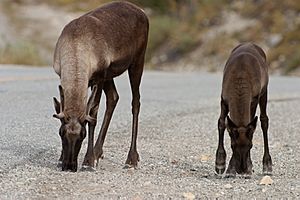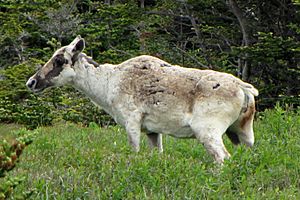Migratory woodland caribou facts for kids
Quick facts for kids Caribou |
|
|---|---|
 |
|
| Female and calf in British Columbia | |
| Scientific classification |
|
| Kingdom: | Animalia |
| Phylum: | Chordata |
| Class: | Mammalia |
| Order: | Artiodactyla |
| Family: | Cervidae |
| Subfamily: | Capreolinae |
| Genus: | Rangifer |
| Species: | |
| Subspecies: |
R. t. caribou
|
| Trinomial name | |
| Rangifer tarandus caribou (Gmelin, 1788)
|
|
 |
|
| Approximate range of Rangifer tarandus caribou in dark brown. Overlap with other subspecies of caribou is possible for contiguous range. 1.Rangifer tarandus caribou subdivided into ecotypes: woodland (boreal), woodland (migratory) and woodland (montane), 2. R. t. dawsoni (extinct 1908), 3. R. t. granti, 4. R. t. groenlandicus, 5. R. t. groenlandicus/pearyi, 6. R. t. pearyi | |
The migratory woodland caribou are a type of reindeer found in North America. They are often called caribou. These animals belong to a group called Rangifer tarandus caribou, or woodland caribou. They live in places like Nunavik, Québec, and Labrador.
Two famous groups of migratory woodland caribou are the Leaf River caribou herd (LRCH) and the George River caribou herd (GRCH). These herds live south of Ungava Bay. Even though they are woodland caribou, they act a lot like barren-ground caribou. For example, they travel thousands of kilometers. They move from their winter homes in the forest to open tundra to have their babies.
The George River herd was once the biggest caribou herd in the world. But their numbers have dropped a lot. This has made life hard for the Inuit and Cree people of Nunavik. They rely on caribou for food. In 1984, about 10,000 caribou from the George River herd drowned. This happened during a river crossing when the James Bay Hydro Project was flooding the area.
Not all caribou herds are in danger. For example, the caribou in Gros Morne National Park in Newfoundland are doing well.
Contents
Caribou Types: Ecotypes
Caribou are medium-sized animals that live in cold places. These include boreal forests, mountains, and Arctic areas. They show many differences in how they live, their genes, how they act, and what they look like. Most caribou live in Canada.
Scientists use different ways to group caribou. They look at their species, their "ecotypes," or natural groups. An ecotype describes how a group of animals lives in its environment. It includes their behavior and habitat.
Caribou Ecotypes in Canada
In eastern North America, caribou are put into three main ecotypes:
- Mountain caribou: Found south of the St. Lawrence River.
- Barren-ground caribou: These caribou have their babies in the tundra.
- Forest-dwelling caribou: These caribou live all year in the boreal forest.
Other parts of Canada also have different caribou ecotypes. For example, in Québec, there are migratory barren-ground, mountain, and forest-dwelling types. In British Columbia, there are mountain, northern, and boreal types.
Caribou Classification

The scientific name for reindeer or caribou is Rangifer tarandus. This name was given by Carl Linnaeus in 1758. The specific name for woodland caribou, Rangifer tarandus caribou, was given by Gmelin in 1788.
Scientists sometimes disagree on how to classify caribou. Some older names for caribou groups, like the Labrador caribou or Newfoundland caribou, were once thought to be the same as R. t. caribou. But some modern scientists believe they are different.
Understanding how caribou live and what challenges they face might be more important than just their family tree. This helps in protecting them.
Caribou Populations in Québec
In 1961, all caribou in Québec were considered the same type: Rangifer tarandus caribou. Scientists have studied the differences between sedentary (staying in one place) caribou in southern Ungava and the migratory Leaf River and George River herds.
Here are the three main caribou ecotypes in Québec:
- The barren-ground ecotype: This is the only type that migrates. They live north of the 52nd parallel. Their numbers were very low until the 1950s. Then they grew to over a million in the early 1990s.
- The mountain ecotype: These caribou are found in southeastern Québec. They mostly stay in the boreal forest. Their numbers have gone down a lot. Now there are only about 140 of them.
- The forest-dwelling ecotype: These caribou live in the boreal forest. They prefer areas where forest fires don't happen often. Their numbers have also decreased. Today, there are probably fewer than 3,000 of them. Hunting might be a big reason for this decline.
Caribou Numbers in Québec
In the late 1800s, caribou in southern Québec moved further north. Their numbers also went down in the eastern part of the province until the 1970s. By 2003, there were only four small groups left south of the 49th parallel.
In 2001, there were over a million caribou in Nunavik. But by 2011, this number had dropped to fewer than 300,000.
Leaf River Caribou Herd (LRCH)
The Leaf River caribou herd lives in the west, near Hudson Bay. This herd grew from 270,000 caribou in 1991 to 628,000 in 2001. However, by 2011, their numbers had gone down to 430,000.
George River Caribou Herd (GRCH)
The George River caribou herd has seen a huge drop in numbers. In the 1980s, there were between 700,000 and 800,000 caribou in this herd. They migrated between northern Québec and Labrador. By 2010, there were only 74,000. By 2012, the number fell to 27,600. And by 2014, there were only 14,200 caribou left.
This herd was once the largest in the world. They travel thousands of kilometers from the forest to the open tundra. Most females have their calves within a three-week period. This behavior is more like barren-ground caribou.
The George River herd was very small in the late 1940s, with only about 3,500 animals. It grew to 15,000 in 1958. By 1988, it reached 700,000, and by 1993, it was 775,000. But then the numbers started to fall. By 2001, it was 385,000, and by 2010, it was 75,000. The most recent survey shows fewer than 28,000.
In 2013, Indigenous groups like the Innu, Inuit, and Cree held emergency meetings. They talked about the "critical decline" of the George River herd. They also discussed the uncertain future of the Leaf River and Torngat herds.
The land is changing and the impacts of climate change, industrial development, and the growing human population and easier accessibility of the herd cannot be ignored in the management actions to be put forward. With the exponential rate of development, the protection of caribou habitat is greatly deficient and needs to be addressed seriously.
The Government of Nunatsiavut suggested protecting the George River caribou calving grounds. They proposed a 14,000 square kilometer protection zone.
| year | population |
|---|---|
| late 1940s | 3,500 |
| 1958 | 15,000 |
| 1988 | 700,000 |
| mid-1990s | 750,000 |
| 2001 | 385,000 |
| 2011 | 74,000 |
| 2012 | 27,600 |
| 2014 | 14,200 |
Caribou Migration
The migratory George River caribou herd travels thousands of kilometers. They move from their winter homes to their calving grounds. These grounds are near the Inuit village of Kangiqsualujjuaq, Nunavik.
Caribou often travel over 2,000 kilometers each year. They live in an area of about 1,000,000 square kilometers. Some caribou have even traveled 6,000 kilometers in one year!
Caribou populations change a lot, and we don't always know why. Their numbers seemed to peak in the late 1700s, 1800s, and 1900s. The recent decline has caused hardship for the Inuit and Cree communities. By 1950, only about 5,000 caribou were left in northern Québec and Labrador.
Caribou Drowning Event in 1984
In September 1984, about 10,000 caribou drowned. This happened while they were crossing the Caniapiscau River in Québec. This was about 2% of the George River herd. They drowned just above the Calcaire (Limestone) Falls.
Caribou regularly cross northern rivers and lakes. They can swim for 10 kilometers at a time. But sometimes, these crossings can be dangerous. People wondered if the Hydro-Québec company was responsible. They had just built a new reservoir upstream on the Caniapiscau River.
Local residents noticed many dead caribou floating in the Koksoak River. Wildlife experts investigated and found the drowned caribou at the base of Calcaire Falls. Coves and backwaters were filled with dead caribou.
There was a debate about what caused the drownings. Some thought it was due to heavy rains and the way the reservoir was managed. Others argued that even more caribou would have died without the reservoir. The dispute was never fully settled.
The Société d'énergie de la Baie James, a part of Hydro-Québec, was criticized. They had just finished building the reservoir. People felt they should have planned better to protect the caribou. No wildlife expert had expected such a large number of deaths.
Later, officials suggested that managing the water levels of the reservoir could have prevented the deaths. They recommended lowering the water level by about 0.5 meters during migration times. Today, very little water is sent back into the lower Caniapiscau River. Also, a fence was put up to guide the caribou away from the dangerous falls.
Threats to Caribou
Human activities that change the landscape are a big reason why caribou numbers are shrinking.
- Logging: When forests are cut down, it can lead to more moose. This means more wolves, who hunt both moose and caribou. Logging also makes it easier for predators to travel and for poachers to access caribou areas.
- Roads and trails: These paths help predators move faster and make it harder for caribou to travel safely.
- Diseases: Logging can create new habitats that attract white-tailed deer. These deer can carry a parasite called Parelaphostrongylus tenuis. This parasite is deadly to caribou and moose.
Research shows that it takes about 20 years for caribou to disappear after a forest is harvested. This is because it takes time for the changes in animal populations to happen. To protect caribou, large areas of old-growth forest are needed. These areas should be far from human disturbances. Some studies suggest keeping at least 13 kilometers between logging operations and caribou habitats.
Climate Change Effects
Climate change could also harm woodland caribou. Warmer climates might change forests, making them better for moose and white-tailed deer. This could spread the deadly parasite. Also, more freezing rain in winter could make it hard for caribou to dig through snow to find their main food, lichens. The full effects of climate change on caribou are still being studied.
Woodland Caribou in the United States
When Europeans first arrived in North America, caribou lived across most of Canada and Alaska. Woodland caribou also lived as far south as New England and the Great Lakes states. By the 1970s, they were gone from the eastern United States and most of eastern Canada.
By 1980, only about 25-30 caribou were left in northern Idaho and northeastern Washington. This small group was listed as endangered in 1984. Today, the woodland caribou is one of the most endangered mammals in the United States. Only a few are found south of the Canadian border each year.
There is only one natural herd of woodland caribou in the US. It lives in northern Idaho, northern Montana, eastern Washington, and British Columbia, Canada. This herd has about 40 animals. There are efforts to bring caribou back to northern Minnesota from the Slate Islands in Lake Superior. However, many white-tailed deer and wolves in that area could make it difficult for the caribou to survive.

